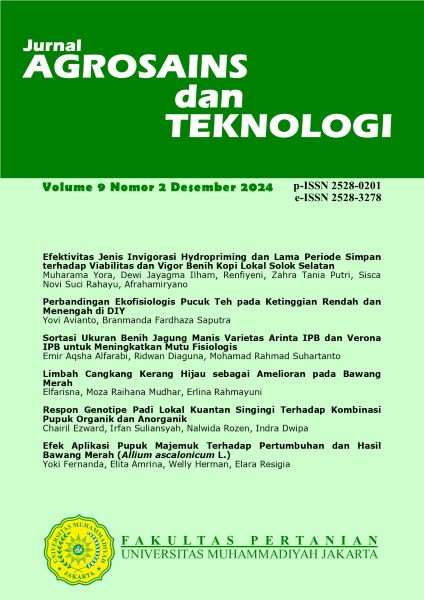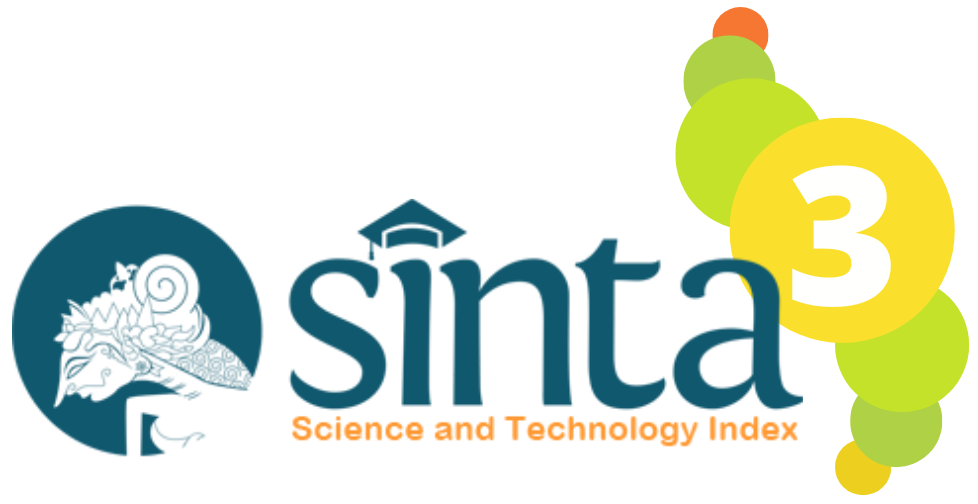Perbandingan Ekofisiologis Pucuk Teh pada Ketinggian Rendah dan Menengah di DIY
DOI:
https://doi.org/10.24853/jat.9.2.%25pKeywords:
Cekaman suhu, ekofisiologi, fotorespirasi, PAR, zona ketinggianAbstract
Tanaman teh merupakan komoditas penting di Indonesia, namun produksinya sangat dipengaruhi oleh ketinggian tempat. Ketinggian yang berbeda akan menghasilkan kondisi iklim mikro yang unik, seperti suhu, kelembaban, dan intensitas cahaya yang berbeda pula. Kondisi iklim mikro ini secara langsung memengaruhi pertumbuhan, fisiologi, dan produktivitas tanaman teh. Penelitian ini bertujuan untuk memahami bagaimana perbedaan ketinggian tempat, khususnya antara dataran rendah dan menengah, mempengaruhi respon fisiologis tanaman teh dan produksi pucuknya di wilayah Yogyakarta. Penelitian dilakukan di dua kebun produksi teh dengan ketinggian tempat berbeda yaitu Turgo (Zona Rendah 514 mdpl) dan Nglinggo (Zona Menengah (852 mdpl) pada bulan Mei – Agustus 2024. Hasil penelitian menunjukkan bahwa tanaman teh yang tumbuh di dataran menengah memiliki keunggulan dibandingkan dataran rendah. Kondisi iklim di dataran menengah, seperti suhu yang lebih sejuk dan kelembaban yang cukup, sangat mendukung pertumbuhan tanaman teh. Kondisi ini membuat tanaman teh di dataran menengah lebih efisien dalam berfotosintesis dan menggunakan air. Akibatnya, tanaman teh di dataran menengah menghasilkan daun yang lebih hijau, lebih luas, dan memiliki laju pertumbuhan yang lebih baik. Hal ini berujung pada peningkatan produktivitas dan kualitas pucuk teh. Pemilihan lokasi penanaman teh yang tepat, terutama di daerah dengan ketinggian menengah, sangat penting untuk mencapai hasil produksi yang optimal.References
Ahmed, S., Griffin, T., Cash, S. B., Han, W.-Y., Matyas, C., Long, C., Orians, C. M., Stepp, J. R., Robbat, A., & Xue, D. (2018). Global Climate Change, Ecological Stress, and Tea Production. In W.-Y. Han, X. Li, & G. J. Ahammed (Eds.), Stress Physiology of Tea in the Face of Climate Change (pp. 1–23). Springer Singapore. https://doi.org/10.1007/978-981-13-2140-5_1
Anjarsari, I. R. D., Rezamela, E., Syahrian, H., & Rahadi, V. H. (2020). Pengaruh cuaca terhadap hasil pucuk teh (Camellia sinensis L.(O) Kuntze) klon GMB 7 pada periode jendangan dan pemetikan produksi. Jurnal Kultiva, 19(1), 1076–1082. https://doi.org/10.24198/kultivasi.v19i1.23375
Avianto, Y., Noviyanto, A., Jaya, G. I., Handru, A., Ferhat, A., Hartanto, E. S., Sidiq, M. F., Saputra, B. F., Ramadhani, J. N., & Shofry, M. A. (2024). Integrating Automated Drip Irrigation and Organic Matter to Improve Enzymatic Performance and Yield of Water Efficient Chilli in Karst Region. Journal of Ecological Engineering, 25(11), 175–187. https://doi.org/10.12911/22998993/192820
Chen, H., Liu, C., Liu, C., Hu, C., Hsiao, M., Chiou, M., Su, Y., & Tsai, H. (2019). A Growth Model to Estimate Shoot Weights and Leaf Numbers in Tea. Agronomy Journal, 111(5), 2255–2262. https://doi.org/10.2134/agronj2019.01.0056
Chia, S. Y., & Lim, M. W. (2022). A critical review on the influence of humidity for plant growth forecasting. IOP Conference Series: Materials Science and Engineering, 1257(1), 012001. https://doi.org/10.1088/1757-899X/1257/1/012001
Dalimoenthe, S. L., Wulansari, R., & Rezamela, E. (2017). DAMPAK PERUBAHAN IKLIM TERHADAP PRODUKTIVITAS PUCUK TEH PADA BERBAGAI KETINGGIAN TEMPAT / Impact of Climate Changes on Leaves Productivity in Various Elevation Levels. Jurnal Penelitian Tanaman Industri, 22(3), 135. https://doi.org/10.21082/littri.v22n3.2016.135-141
Duncan, J. M. A., Saikia, S. D., Gupta, N., & Biggs, E. M. (2016). Observing climate impacts on tea yield in Assam, India. Applied Geography, 77, 64–71. https://doi.org/10.1016/j.apgeog.2016.10.004
Gunathilaka, R. P. D., & Tularam, G. A. (2016). The Tea Industry and a Review of Its Price Modelling in Major Tea Producing Countries. Journal of Management and Strategy, 7(1), p21. https://doi.org/10.5430/jms.v7n1p21
Hajiboland, R. (2017). Environmental and nutritional requirements for tea cultivation. Folia Horticulturae, 29(2), 199–220. https://doi.org/10.1515/fhort-2017-0019
Han, W.-Y., Huang, J.-G., Li, X., Li, Z.-X., Ahammed, G. J., Yan, P., & Stepp, J. R. (2017). Altitudinal effects on the quality of green tea in east China: A climate change perspective. European Food Research and Technology, 243(2), 323–330. https://doi.org/10.1007/s00217-016-2746-5
Jayasinghe, S. L., & Kumar, L. (2021). Potential Impact of the Current and Future Climate on the Yield, Quality, and Climate Suitability for Tea [Camellia sinensis (L.) O. Kuntze]: A Systematic Review. Agronomy, 11(4), 619. https://doi.org/10.3390/agronomy11040619
Jespersen, D., Zhang, J., & Huang, B. (2016). Chlorophyll loss associated with heat-induced senescence in bentgrass. Plant Science, 249, 1–12. https://doi.org/10.1016/j.plantsci.2016.04.016
Kibblewhite, M. G., Prakash, S., Hazarika, M., Burgess, P. J., & Sakrabani, R. (2014). Managing declining yields from ageing tea plantations. Journal of the Science of Food and Agriculture, 94(8), 1477–1481. https://doi.org/10.1002/jsfa.6543
Klinges, D. H., & Scheffers, B. R. (2021). Microgeography, Not Just Latitude, Drives Climate Overlap on Mountains from Tropical to Polar Ecosystems. The American Naturalist, 197(1), 75–92. https://doi.org/10.1086/711873
Kumar, R., Bisen, J. S., Choubey, M., Singh, M., & Bera, B. (2015). Studies on effect of altitude and environment on physiological activities and yield of Darjeeling tea (Camellia sinensis L.) plantation. Journal Crop and Weed, 11, 71–79.
Li, X., Wu, L., Geng, X., Xia, X., Wang, X., Xu, Z., & Xu, Q. (2018). Deciphering the Environmental Impacts on Rice Quality for Different Rice Cultivated Areas. Rice, 11(1), 7. https://doi.org/10.1186/s12284-018-0198-1
Liebig, T., Ribeyre, F., Läderach, P., Poehling, H.-M., Van Asten, P., & Avelino, J. (2019). Interactive effects of altitude, microclimate and shading system on coffee leaf rust. Journal of Plant Interactions, 14(1), 407–415. https://doi.org/10.1080/17429145.2019.1643934
Liu, S.-C., Yao, M.-Z., Ma, C.-L., Jin, J.-Q., Ma, J.-Q., Li, C.-F., & Chen, L. (2015). Physiological changes and differential gene expression of tea plant under dehydration and rehydration conditions. Scientia Horticulturae, 184, 129–141. https://doi.org/10.1016/j.scienta.2014.12.036
Lou, W., Sun, K., Zhao, Y., Deng, S., & Zhou, Z. (2021). Impact of climate change on inter‐annual variation in tea plant output in Zhejiang, China. International Journal of Climatology, 41(S1). https://doi.org/10.1002/joc.6700
Marchin, R. M., Backes, D., Ossola, A., Leishman, M. R., Tjoelker, M. G., & Ellsworth, D. S. (2022). Extreme heat increases stomatal conductance and drought‐induced mortality risk in vulnerable plant species. Global Change Biology, 28(3), 1133–1146. https://doi.org/10.1111/gcb.15976
Martin-Avila, E., Lim, Y.-L., Birch, R., Dirk, L. M. A., Buck, S., Rhodes, T., Sharwood, R. E., Kapralov, M. V., & Whitney, S. M. (2020). Modifying Plant Photosynthesis and Growth via Simultaneous Chloroplast Transformation of Rubisco Large and Small Subunits. The Plant Cell, 32(9), 2898–2916. https://doi.org/10.1105/tpc.20.00288
Moore, C. E., Meacham-Hensold, K., Lemonnier, P., Slattery, R. A., Benjamin, C., Bernacchi, C. J., Lawson, T., & Cavanagh, A. P. (2021). The effect of increasing temperature on crop photosynthesis: From enzymes to ecosystems. Journal of Experimental Botany, 72(8), 2822–2844. https://doi.org/10.1093/jxb/erab090
Muningsih, R., Indradewa, D., & Sulistyaningsih, E. (2014). Physiological Characters and Yield of Tea Shoots at Some Age of Production Pruning and Altitude. Ilmu Pertanian (Agricultural Science), 17(1), 25. https://doi.org/10.22146/ipas.4922
Nyabundi, K. W., Owuor, P. O., Netondo, G. W., & Bore, J. K. (2019). Radiation Use Efficiency and Yield Responses of Clonal Tea (Camellia sinensis) to Locations of Production. International Journal of Tea Science, 14(1), 26–38. https://doi.org/10.20425/ijts1414
Özdemi̇r, F., Şahi̇n Nadeem, H., Akdoğan, A., Di̇nçer, C., & Topuz, A. (2018). Effect of altitude, shooting period, and tea grade on the catechins, caffeine, theaflavin, and thearubigin of Turkish black tea. TURKISH JOURNAL OF AGRICULTURE AND FORESTRY, 42(5), 334–340. https://doi.org/10.3906/tar-1710-21
Pang, J., Li, H., Tang, X., & Geng, J. (2019). Carbon dynamics and environmental controls of a hilly tea plantation in Southeast China. Ecology and Evolution, 9(17), 9723–9735. https://doi.org/10.1002/ece3.5504
Posch, B. C., Kariyawasam, B. C., Bramley, H., Coast, O., Richards, R. A., Reynolds, M. P., Trethowan, R., & Atkin, O. K. (2019). Exploring high temperature responses of photosynthesis and respiration to improve heat tolerance in wheat. Journal of Experimental Botany, 70(19), 5051–5069. https://doi.org/10.1093/jxb/erz257
Rachman, A. L., Anjarsari, I. R. D., Soleh, M. A., & Rezamela, E. (2024). Keefektifan Penggunaan Pupuk Anorganik dan Aplikasi Kitosan dalam Meningkatkan Pertumbuhan dan Hasil Tanaman Teh (Camellia sinensis L.). Agrikultura, 35(1), 164. https://doi.org/10.24198/agrikultura.v35i1.53754
Raj, E. E., Ramesh, K. V., & Rajkumar, R. (2019). Modelling the impact of agrometeorological variables on regional tea yield variability in South Indian tea-growing regions: 1981-2015. Cogent Food & Agriculture, 5(1), 1581457. https://doi.org/10.1080/23311932.2019.1581457
Sakiroh, S., Sasmita, K. D., & Astutik, D. (2021). Pengaruh Naungan dan Ketinggian Tempat terhadap Produksi Pucuk Teh (Camellia sinensis L.). Prosiding Seminar Nasional Lahan Suboptimal. Seminar Nasional Lahan Suboptimal, Palembang.
Setiyaningrum, A. A., Darmawati, A., & Budiyanto, S. (2019). Pertumbuhan dan produksi tanaman kailan (Brassica oleracea) akibat pemberian mulsa jerami padi dengan takaran yang berbeda. Journal of Agro Complex, 3(1), 75. https://doi.org/10.14710/joac.3.1.75-83
Shah Jahan, M., Wang, Y., Shu, S., Zhong, M., Chen, Z., Wu, J., Sun, J., & Guo, S. (2019). Exogenous salicylic acid increases the heat tolerance in Tomato (Solanum lycopersicum L) by enhancing photosynthesis efficiency and improving antioxidant defense system through scavenging of reactive oxygen species. Scientia Horticulturae, 247, 421–429. https://doi.org/10.1016/j.scienta.2018.12.047
Sukmadi, S., Kasim, F., Simatupang, V., Goeltom, A. D. L., & Saftara, I. (2020). Strategi Pengembangan Wisata Berbasis Kearifan Lokal pada Desa Wisata Pagerharjo Kecamatan Samigaluh Kabupaten Kulon Progo Yogyakarta. Masyarakat Pariwisata : Journal of Community Services in Tourism, 1(1), 1–12. https://doi.org/10.34013/mp.v1i1.356
Usodri, K. S., Widiyani, D. P., & Supriyatdi, D. (2022). Hubungan antar beberapa unsur iklim mikro pada produksi tanaman karet (Hevea brassiliensis) klon PB260. Jurnal Agrosains Dan Teknologi, 7(2), 75–80. https://doi.org/10.24853/jat.7.2.75-80
Wang, B., Chen, J., Chen, L., Wang, X., Wang, R., Ma, L., Peng, S., Luo, J., & Chen, Y. (2015). Combined drought and heat stress in Camellia oleifera cultivars: Leaf characteristics, soluble sugar and protein contents, and Rubisco gene expression. Trees, 29(5), 1483–1492. https://doi.org/10.1007/s00468-015-1229-9
Wijayanto, A., Indradewa, D., & Putra, E. T. S. (2015). KUANTITAS DAN KUALITAS HASIL PUCUK ENAM KLON TEH SINENSIS (Camellia sinensis (L.) O. Kuntze var Sinensis) DI BAGIAN KEBUN KAYULANDAK, PT. PAGILARAN. Vegetalika, 4(3), 42–56. https://doi.org/10.22146/veg.10476
Wu, B.-S., Rufyikiri, A.-S., Orsat, V., & Lefsrud, M. G. (2019). Re-interpreting the photosynthetically action radiation (PAR) curve in plants. Plant Science, 289, 110272. https://doi.org/10.1016/j.plantsci.2019.110272
Wulansari, R., Athallah, F., & Pramudita, A. (2022). Effect of slope and year of pruning of tea plants on soil water content in Indonesian tea plantations. Soil Science Annual, 73(4), 1–7. https://doi.org/10.37501/soilsa/157103
Xiang, P., Zhu, Q., Tukhvatshin, M., Cheng, B., Tan, M., Liu, J., Wang, X., Huang, J., Gao, S., Lin, D., Zhang, Y., Wu, L., & Lin, J. (2021). Light control of catechin accumulation is mediated by photosynthetic capacity in tea plant (Camellia sinensis). BMC Plant Biology, 21(1), 478. https://doi.org/10.1186/s12870-021-03260-7
Yan, P., Wu, L., Wang, D., Fu, J., Shen, C., Li, X., Zhang, L., Zhang, L., Fan, L., & Wenyan, H. (2020). Soil acidification in Chinese tea plantations. Science of The Total Environment, 715, 136963. https://doi.org/10.1016/j.scitotenv.2020.136963
Yang, Y., Zhang, S., Wu, J., Gao, C., Lu, D., & Tang, D. W. S. (2022). Effect of long term application of super absorbent polymer on soil structure, soil enzyme activity, photosynthetic characteristics, water and nitrogen use of winter wheat. Frontiers in Plant Science, 13, 998494. https://doi.org/10.3389/fpls.2022.998494
Ye, J.-H., Lv, Y.-Q., Liu, S.-R., Jin, J., Wang, Y.-F., Wei, C.-L., & Zhao, S.-Q. (2021). Effects of Light Intensity and Spectral Composition on the Transcriptome Profiles of Leaves in Shade Grown Tea Plants (Camellia sinensis L.) and Regulatory Network of Flavonoid Biosynthesis. Molecules, 26(19), 5836. https://doi.org/10.3390/molecules26195836
Zakir, M. (2018). Review on Impacts of Climate Change on Tea Yield, Yield Components and Quality. International Journal of Research Studies in Agricultural Sciences, 4(5), 24–37. http://dx.doi.org/10.20431/2454-6224.0405005
Zhang, W., Ni, K., Long, L., & Ruan, J. (2023). Nitrogen transport and assimilation in tea plant (Camellia sinensis): A review. Frontiers in Plant Science, 14, 1249202. https://doi.org/10.3389/fpls.2023.1249202
Zhao, H., Zhang, P., Wang, Y., Ning, T., Xu, C., & Wang, P. (2020). Canopy morphological changes and water use efficiency in winter wheat under different irrigation treatments. Journal of Integrative Agriculture, 19(4), 1105–1116. https://doi.org/10.1016/S2095-3119(19)62750-4
Zhu, Y., Cheng, Z., Feng, K., Chen, Z., Cao, C., Huang, J., Ye, H., & Gao, Y. (2022). Influencing factors for transpiration rate: A numerical simulation of an individual leaf system. Thermal Science and Engineering Progress, 27, 101110. https://doi.org/10.1016/j.tsep.2021.101110











